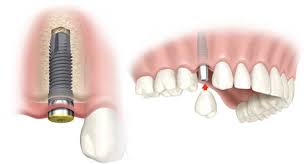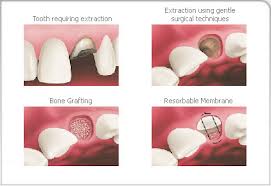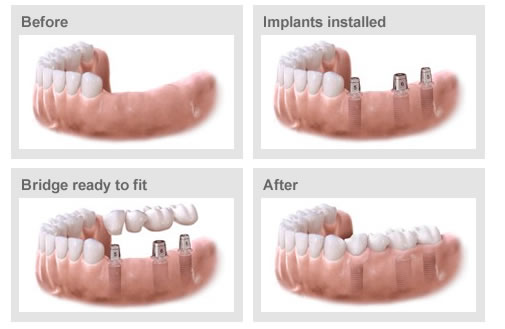A dental implant is a “Root” device usually made of a titanium to support restorations that resemble a tooth or group of teetch to replace missing teeth.
All dental implants placed today are root form endosseous implants i.e, they apear similar to a actual tooth root and are placed with in the bone. The bone of the jaw accepts and osseo integrates (fusion of the implant surface with the surrouding bone).
Single tooth implants are used in people who are missing one or more teeth. An implant is surgically placed in an opening that is made in the jaw bone. After the implant integrates (attaches) to the bone it acts as a new root for the crown that will be replacing your missing tooth. A crown which is made to look a natural tooth is attached to the impalnt and fills the space left in the mouth by the missing tooth.

When multiple teeth are missing the support to make a bridge is taken by implants instead of the natural teeth. In this the natural teeth are preserved from grinding. Number of implants to be given depends on the number of the teeth missing.


Dental implants provide several advantages over other teeth replacement options. In addition to looking and functioning like natural teeth, implant-supported bridges replace teeth without support from adjacent natural teeth. Other common treatments for the loss of several teeth, such as fixed bridges or removable partial dentures, are dependent on support from adjacent teeth. In addition, because implant-supported bridges will replace some of your tooth roots, your bone is better preserved. With a fixed bridge or removable partial denture, the bone that previously surrounded the tooth root may begin to resorb (deteriorate). Dental implants integrate with your jawbone, helping to keep the bone healthy and intact. In the long term, implants are esthetic, functional and comfortable. Gums and bone can recede around a fixed bridge or removable partial denture, leaving a visible defect. Resorbed bone beneath bridges or removable partial dentures can lead to a collapsed, unattractive smile. The cement holding bridges in place can wash out, allowing bacteria to decay teeth that anchor the bridge. In addition, removable partial dentures can move around in the mouth and reduce your ability to eat certain foods.
Average Range of treatment Life Expectancy
Indefinite. Annual touch - ups may be required, but treatment may last indefinitely.